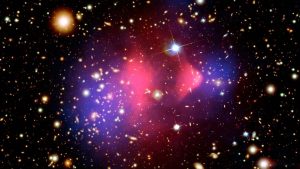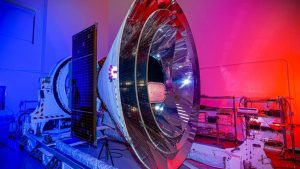Nuclear fusion breakthrough: Scientists generate more power than used to create reaction
On Tuesday, the head of the Department of Energy and other federal scientific leaders announced that a fusion reaction run at the Lawrence Livermore National Laboratory in California achieved net energy, meaning the reaction generated more energy than was put in to initiate the reaction. It is the first time humankind has achieved this landmark.
Fusion is the way that the sun makes power, but recreating a useful fusion reaction here on earth has eluded scientists for decades. Achieving net positive energy paves the way for fusion to move from a lab science to a usable energy source, although large scale commercialization of fusion could still be decades away.
Fusion is particularly attractive given the increasing urgency of climate change because if it can be commercialized at scale, it produces no carbon emissions, nor does it produce the long-lasting nuclear waste associated with nuclear fission, which is the type of nuclear energy used to make energy today.
The National Ignition Facility target chamber at the Lawrence Livermore National Laboratory is where scientists shoot lasers and watch and measure what happens when those lasers collide on a fuel source. Temperatures of 100 million degrees and pressures extreme enough to compress a target up to 100 times the density of lead are created in this facility.
Photo by Damien Jemison/ Lawrence Livermore National Laboratory
“Monday, December 5, 2022 was an important day in science,” Jill Hruby, the National Nuclear Security Administration Administrator, said at a press conference announcing the news on Tuesday in Washington D.C. “Reaching ignition in a controlled fusion experiment is an achievement that has come after more than 60 years of global research, development, engineering and experimentation.”
Reaching ignition means the fusion experiment produced more energy from fusion than the laser energy that used to drive the reaction. Since the experiment, the team has been analyzing data to be able to make this official announcement.
“This is important. Earlier results were records, but not yet producing more energy out than was put in,” Andrew Holland, the CEO of the industry’s trade group, the Fusion Industry Association, told CNBC. “For the first time on Earth, scientists have confirmed a fusion energy experiment released more power than it takes to initiate, proving the physical basis for fusion energy. This will lead fusion to be a safe and sustainable energy source in the near future.”
In the experiment on Dec. 5, about two megajoules (a unit of energy) went into the reaction and about three megajoules came out, said Marvin Adams, Deputy Administrator for Defense Programs at the National Nuclear Security Administration. “A gain of 1.5,” Adams said.
For the experiment, super high powered lasers are all directed at a very tiny fuel target at the National Ignition Facility at the Lawrence Livermore National Laboratory. “During experiments, 192 high energy lasers converge on a target about the size of a peppercorn heating a capsule of deuterium and tritium to over 3 million degrees Celsius and briefly simulating the conditions of a star,” Hruby said.
The main mission of the National Lab is studying nuclear power for use in national defense, and this nuclear fusion research is part of an effort established in 1996 by then President Clinton to maintain confidence in the safety of nuclear weapons stockpiles without full-scale nuclear testing.
But this discovery has massive implications for clean energy, too. In addition to the national security work, “we have taken the first tentative steps towards a clean energy source that could revolutionize the world,” Hruby said.
While this scientific breakthrough that is being celebrated at the highest levels of government, it will be many years before fusion power plants are likely to provide clean abundant energy.
“This is one igniting capsule, one time. And to realize commercial fusion energy, you have to do many things. You have to be able to produce many, many fusion ignition events per minute,” Kim Budil, the director of the Lawrence Livermore Lab, said on Tuesday.
“You have to have a robust system of drivers to enable that. So, you know, probably decades. Not six decades, I don’t think. Not five decades, which is what we used to say. I think it’s moving into the foreground and probably, with concerted effort and investment, a few decades of research on the underlying technologies could put us in a position to build a power plant.”
Omar A. Hurricane, Chief Scientist for the Inertial Confinement Fusion Program at Lawrence Livermore, explained, “What remains to be done from here is largely engineering, of increasing the laser energy efficiency and increasing the target energy gain with further target optimizations.”
Hurricane added, “This new result does indeed bring commercial fusion closer, as it demonstrates that there are no fundamental physics obstacles. It is starting to feel like we are entering the ‘Fusion Age.'”
One step forward in the ‘Fusion Age’
Interest in fusion has increased dramatically in recent years as concerns about climate change and energy security have become more acute.
More than 90 nuclear power reactors currently operate in the United States, but those nuclear reactors employ nuclear fission, which is when a neutron smashes into a larger atom, causing it to split into two smaller atoms and releasing a lot of energy. Nuclear fission reactions do not release any carbon dioxide emissions and therefore are considered clean energy, according to the U.S. Department of Energy.
The United States got approximately 19 percent of its utility-scale electricity generation from those nuclear power plants in 2021, according to the U.S. Energy Information Administration, and the energy from nuclear fission reactors represents half of the clean power generated in the United States, according to the Department of Energy.
However, those reactors generate long-lasting nuclear radioactive waste, and most countries, including the United States, currently have no long-term storage facilities for that waste. Efforts to build a permanent, underground geologic storage facility for nuclear waste have thus far been stymied in the United States.
Fusion happens when two atoms slam together to form a heavier atom, releasing huge amounts of energy without generating carbon dioxide emissions or long-lasting nuclear waste. But it’s proven extremely challenging to sustain a fusion reaction here on earth, and scientists have been trying for decades. In particular, it requires massive amounts of energy to generate fusion on reactions, and until this experiment, nobody had demonstrated the ability to get more energy out of the reaction than it takes to power it.
“Scientists have struggled to show that fusion can release more energy out than is put in since the 1950s,” plasma physicist Arthur Turrell told CNBC.
“During those decades, every time anyone has asked for funding for developing fusion power, the response has always been ‘first, you must show that it works in principle,'” said Turrell, who is also the author of The Star Builders. “That is, you must show that a fusion experiment can produce more energy than it uses. The researchers at Lawrence Livermore have done this for the first time ever.”
Fusion is already a hot space for climate and energy investors — so far, investors have poured almost $5 billion in investment into private fusion energy startups, according to the Fusion Industry Association, and more than half of that has been since since the second quarter of 2021.
“Everyone in the laser fusion (or inertial confinement fusion) community has been focused on getting to more energy out than in on a single experiment, because that is the key to showing the proof of principle and unlocking further investment and interest,” Turrell told CNBC.
Indeed, the private fusion industry is seeing this as a win.
“Now, the privately funded fusion industry will take the next steps, turning experimental results like this into a viable source of clean, safe energy,” Holland told CNBC. “In short, this will show the world that fusion is not science fiction: it will soon be a viable source of energy. Of course there are still many steps between these experimental results and fusion power plants, but this is an important milestone that brings us closer to the day when fusion will provide the world with clean, safe, and abundant energy.”







